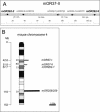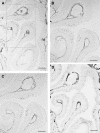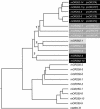The clustered olfactory receptor gene family 262: genomic organization, promotor elements, and interacting transcription factors
- PMID: 14656972
- PMCID: PMC403809
- DOI: 10.1101/gr.1372203
The clustered olfactory receptor gene family 262: genomic organization, promotor elements, and interacting transcription factors
Abstract
For six mouse olfactory receptor genes from family 262 which are expressed in clustered populations of olfactory sensory neurons, the genomic as well as cDNA structures were deciphered. All genes contained several exons which in some cases were alternatively spliced. Immediately upstream of the transcription start sites, sequence motif blocks were identified that are highly conserved among olfactory receptor (OR) genes which are expressed in clustered neuronal populations. By means of electrophoretic mobility shift assays, it was demonstrated that segments of the motif block region interact with proteins extracted from nuclear fractions of the olfactory epithelium. Yeast one-hybrid screenings of an olfactory cDNA library led to the identification of a set of transcription factors that specifically bind to particular elements of the motif block region. The identified factors can be categorized into two types: One group is known to be involved in transcriptional initiation, and the second group represents factors involved in pattern formations. The identified components may contribute to govern the precise topographic expression pattern of olfactory receptor genes.
Figures









Similar articles
-
Promoter motifs of olfactory receptor genes expressed in distinct topographic patterns.Genomics. 2006 Jun;87(6):711-23. doi: 10.1016/j.ygeno.2006.02.005. Epub 2006 Apr 4. Genomics. 2006. PMID: 16600568
-
The LIM-homeodomain protein Lhx2 is required for complete development of mouse olfactory sensory neurons.Proc Natl Acad Sci U S A. 2004 Jun 8;101(23):8751-5. doi: 10.1073/pnas.0400940101. Epub 2004 Jun 1. Proc Natl Acad Sci U S A. 2004. PMID: 15173589 Free PMC article.
-
Promotor elements governing the clustered expression pattern of odorant receptor genes.Mol Cell Neurosci. 2007 Sep;36(1):95-107. doi: 10.1016/j.mcn.2007.06.005. Epub 2007 Jul 4. Mol Cell Neurosci. 2007. PMID: 17656108
-
Odorant receptor diversity and patterned gene expression in the mammalian olfactory epithelium.Prog Clin Biol Res. 1994;390:75-84. Prog Clin Biol Res. 1994. PMID: 7724652 Review.
-
From genotype to olfactory neuron phenotype: the role of the Olf-1-binding site.Ciba Found Symp. 1993;179:3-20; discussion 20-6. doi: 10.1002/9780470514511.ch2. Ciba Found Symp. 1993. PMID: 8168381 Review.
Cited by
-
Unravelling the complexity of human olfactory receptor repertoire by copy number analysis across population using high resolution arrays.PLoS One. 2013 Jul 3;8(7):e66843. doi: 10.1371/journal.pone.0066843. Print 2013. PLoS One. 2013. PMID: 23843967 Free PMC article.
-
Differentiation of developing olfactory neurons analysed in terms of coupled epigenetic landscapes.Nucleic Acids Res. 2013 May;41(9):4755-64. doi: 10.1093/nar/gkt181. Epub 2013 Mar 21. Nucleic Acids Res. 2013. PMID: 23519617 Free PMC article.
-
Evolution of the "OR37" subfamily of olfactory receptors: a cross-species comparison.J Mol Evol. 2006 Apr;62(4):460-72. doi: 10.1007/s00239-005-0093-4. Epub 2006 Mar 17. J Mol Evol. 2006. PMID: 16547640
-
Achieving singularity in mammalian odorant receptor gene choice.Chem Senses. 2010 Jul;35(6):447-57. doi: 10.1093/chemse/bjq041. Epub 2010 May 11. Chem Senses. 2010. PMID: 20460312 Free PMC article. Review.
-
Diversity and complexity in chromatin recognition by TFII-I transcription factors in pluripotent embryonic stem cells and embryonic tissues.PLoS One. 2012;7(9):e44443. doi: 10.1371/journal.pone.0044443. Epub 2012 Sep 10. PLoS One. 2012. PMID: 22970219 Free PMC article.
References
-
- Asai, H., Kasai, H., Matsuda, Y., Yamazaki, N., Nagawa, F., Sakano, H., and Tsuboi, A. 1996. Genomic structure and transcription of a murine odorant receptor gene: Differential initiation of transcription in the olfactory and testicular cells. Biochem. Biophys. Res. Commun. 221: 240-247. - PubMed
-
- Buck, L. and Axel, R. 1991. A novel multigene family may encode odorant receptors: A molecular basis for odor recognition. Cell 65: 175-187. - PubMed
-
- Buettner, J.A., Glusman, G., Ben-Arie, N., Ramos, P., Lancet, D., and Evans, G.A. 1998. Organization and evolution of olfactory receptor genes on human chromosome 11. Genomics 53: 56-68. - PubMed
-
- Buiakova, O.I., Krishna, N.S., Getchell, T.V., and Margolis, F.L. 1994. Human and rodent OMP genes: Conservation of structural and regulatory motifs and cellular localization. Genomics 20: 452-462. - PubMed
Publication types
MeSH terms
Substances
LinkOut - more resources
Full Text Sources
Molecular Biology Databases
